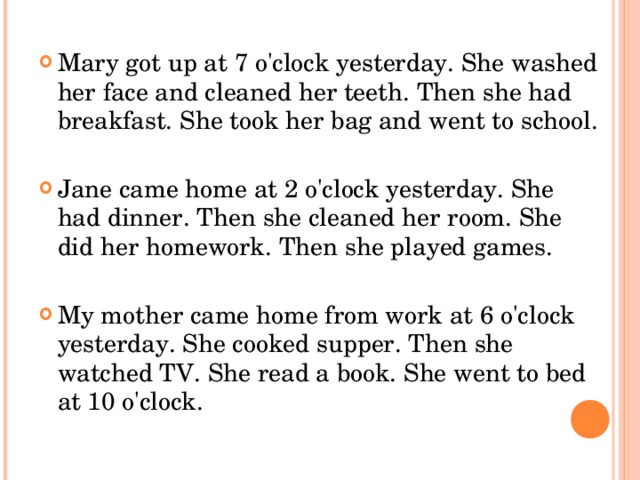Baby arm shaking when feeding
12 Important Reasons to Investigate
If your baby’s arm is shaking or your child is trembling or shaking in other ways, this article will help you identify possible reasons – from a normal immature nervous system, newborn reflexes, and shuddering attacks to metabolic issues, illnesses, and seizures.
Also learn the signs that you should contact a doctor.
Dad’s Question:
Our 4 1/2-month-old baby’s arm is shaking! It starts to shake when he is attempting to grab something and can’t get his grip on it or when getting annoyed or sleepy and is about to cry. It appears it’s mainly when these things are happening around him that this begins.
When we hold his hands, the shaking stops but when you let go, it picks right back up again. The best way to describe it would be as if someone was super excited or nervous that their arms would be shaking in that way.
We don’t know if this is just a part of growing up or something a bit more serious. These happen throughout the day and other times he holds his hands nice and straight.
Is it any kind of neuro problem?? I would appreciate any input!
Thank you!
Isaac
Normal Shaking in Baby
1. Immature Nervous System
What you describe may be normal shaking due to your baby’s immature nervous system, or other expected reasons.
I remember believing that my firstborn suffered from some kind of brain damage when she was a newborn due to her weird movements and shaking… But it turned out to be completely normal newborn movements.
Certain shaking movements are normal and expected during infancy. Such movements are typically brief, and can be easily stopped by holding the affected body part. During the shaking episode, the baby otherwise seems normal, and shows no signs of illness. Normal shaking movements self-resolve as the baby grows and the brain matures.
2. Newborn reflexes
The nervous system of full-term infants is immature at birth, and even more so in premature infants.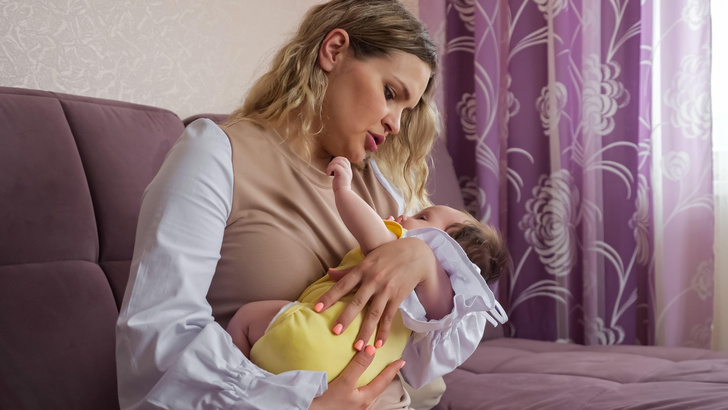 Reflex movements that are present during the first few months of life are replaced by new developmental skills as the baby grows.
Reflex movements that are present during the first few months of life are replaced by new developmental skills as the baby grows.
Moro Reflex
This movement is a sudden, brief jerking of the arms and legs with the fingers fanning outward on the hands. The shaking stops when the arms or legs are held. It is typically seen when a baby becomes startled or something unexpected occurs. The baby may also cry. It is normal for this reflex to occur several times a day, including during sleep. In most babies, it resolves by age four months.
Tonic-Neck Reflex
Also called the “fencing reflex,” this movement occurs when a parent turns the baby’s head toward the shoulder. In response, the arm reflexively extends outward in the same direction as the head. Instead of a shaking motion, it is more of an arm stiffening. This reflex resolves between five to seven months old.
3. Crying movements
When infants become upset, they may exhibit brief shaking movements on various areas of the body. Lip quivering is common, both prior to or during a crying episode. Newborns may shake their arms and legs vigorously while crying, but this should resolve by age two months.
Lip quivering is common, both prior to or during a crying episode. Newborns may shake their arms and legs vigorously while crying, but this should resolve by age two months.
4. Shuddering Attacks
Shuddering attacks are brief but sudden, uncontrollable movements of the head and arms. The infant or toddler otherwise appears normal during the episodes, and there is no loss of consciousness. In many ways, however, the episodes resemble seizures.
Here is a video showing what such an attack may look like:
Infant shudder syndrome
Watch this video on YouTube
Because it is difficult to for parents to distinguish this type of shaking from more concerning conditions, they should consult a doctor. Shuddering attacks require no treatment, and self-resolve by age two to three.
Abnormal Shaking in Babies
Other shaking movements in infants are a sign of a medical problem. They are often described as jitteriness or tremors: involuntary, rhythmic, and periodic movements.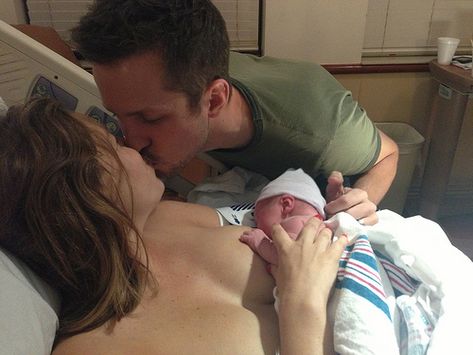 The shaking persists despite holding the affected area, and may be associated with a change in behavior or consciousness.
The shaking persists despite holding the affected area, and may be associated with a change in behavior or consciousness.
In these situations, a doctor should evaluate the cause of the shaking, and determine if treatment is necessary.
Metabolic problems
5. Hypoglycemia
Some infants experience low blood sugar during the first few days of life. While a modest decrease during the initial hours is normal, routine newborn care promotes stabilization of the blood sugar level. This includes immediately drying and warming the baby, and initiating feedings.
Risk factors for persistent hypoglycemia are intrauterine growth retardation, low birth weight, maternal diabetes, and prematurity . In other cases, a complicated birth process can cause stress that depletes the infant’s glucose reserves. Persistence of low blood sugar usually indicates the presence of another medical problem.
The movement seen in infants with hypoglycemia can be described as jitteriness. Other signs include difficulty maintaining a normal body temperature, poor feeding, and irritability. In severe cases, seizures or coma can develop.
Other signs include difficulty maintaining a normal body temperature, poor feeding, and irritability. In severe cases, seizures or coma can develop.
6. Vitamin D Deficiency
Vitamin D is important for a variety of normal body functions. It is essential for the absorption of calcium into bones, and it plays a role in immunity and the prevention of chronic diseases.
Low vitamin D levels have been documented in newborns who have tremors. It is believed that low transfer of vitamin D from the mother to the fetus contributes to this. Tremors resolve once vitamin D supplementation is initiated after birth.
In addition, breastmilk is naturally low in vitamin D. The World Health Organization and American Academy of Pediatrics, therefore, recommend vitamin D supplements for all breastfed infants. Infant formulas are fortified with vitamin D, so supplementation is unnecessary for formula-fed infants.
7. Magnesium Deficiency
Magnesium is an electrolyte that helps the skeletal muscles and heart contract properly, and is important for a variety of metabolic functions. Vitamin D, estrogen, and the kidneys all help to maintain normal magnesium levels in the blood.
Vitamin D, estrogen, and the kidneys all help to maintain normal magnesium levels in the blood.
Very low levels can cause infantile tremor syndrome, seen most often between the ages of six to 30 months.; Frequent shaking movements occur while the baby is awake, but not during sleep. Magnesium supplementation not only improves this condition, but prevents future associated developmental delays.
This condition is rare in situations where adequate nutrition is available.
Seizures
When parents witness any form of shaking, their first thought may be, “Is my baby having a seizure?”; Seizures are unusual body movements or behaviors that occur due to a specific trigger. Many parents are familiar with seizures that involve the whole body stiffening or jerking, and during which consciousness is lost.
Other types of seizures may affect only one area of the body, or be associated with no movement at all; the baby is “awake,” but unresponsive during the latter type. Many seizures are associated with abnormal brain wave activity that can be detected by an electroencephalogram (EEG).
Many seizures are associated with abnormal brain wave activity that can be detected by an electroencephalogram (EEG).
Any infant who experiences such symptoms should be evaluated by a healthcare provider.
8. Febrile Seizures
In the presence of illnesses, rapid increases in body temperature can trigger a seizure in infants and toddlers. The whole body shakes or jerks, the eyes roll back, and there is a loss of consciousness during these episodes. They are common between the ages of six months to three years old, and may reoccur during subsequent febrile illnesses.
Unlike other seizures types, there is no short-term or long-term brain injury. Aside from fever management, no medications are necessary. Most children outgrow this tendency by age five.
9. Infantile Spasms
Infantile spasms develop between the ages of two to 12 months old. They are characterized by repetitive spasms which last only five to ten seconds. In many cases, the episodes are very subtle and difficult to recognize.
The most concerning aspect is the detrimental effect on infant development. Previously achieved motor, social, and cognitive milestones are lost. For example, a four-month-old who frequently coos and smiles will stop doing so. Because of the potential for poor outcomes, it is important for these babies to receive an evaluation by a pediatric neurologist as soon as such changes are detected.
10. Seizures Due to Other Medical Problems, including Infections
There are numerous medical conditions for which seizures are a primary symptom. Seizures are common in infants who experience birth trauma or are born with a brain malformation. One in 2500 infants is born with a genetic or metabolic disorder that can be associated with seizures.
A potentially preventable cause is infection, and prompt medical intervention is critical to a good prognosis.
Meningitis is an inflammation of the protective sac that surrounds the brain and spinal cord. Viruses, bacteria, fungi, and tuberculosis can all cause this condition. During the first three months of life, infants are at high risk of bacterial meningitis caused by group B Streptococcus, E. Coli, or Listeria monocytogenes.
During the first three months of life, infants are at high risk of bacterial meningitis caused by group B Streptococcus, E. Coli, or Listeria monocytogenes.
These infections are most often transmitted perinatally from mom, but may not be evident for several weeks. Older infants are prone to developing pneumococcal and meningococcal infections.
Infants who develop bacterial meningitis usually become quite ill. Classic signs are a bulging “soft spot,” lethargy, or irritability.; Those who survive develop seizures after recovery, along with other neurological deficits.
Encephalitis is defined as inflammation of the brain tissue itself. In infants, herpes viruses are the most common etiology. Similar to cases of meningitis, infants with encephalitis appear very ill, and have diminished responsiveness and fevers. They may experience seizures during the acute phase of the illness, and after recovery.
Other causes of shaking in babies
11.
 Benign Spasms of Infancy
Benign Spasms of InfancyThis condition was previously known as non-epileptic infantile spasms or benign myoclonus because of the “jerking” nature of the movements. During the episodes, the head, neck, and upper body experience a one to two-minute spasm. Despite their appearance, benign spasms of infancy are not seizures.
The average age of onset is five months old, with resolution by age three.
12. Neonatal Abstinence Syndrome
Infants who have had prenatal exposure to opioids, alcohol, and other substances can develop jitteriness and tremors a few days after birth. Other symptoms include high-pitched crying, irritability, difficulty sleeping, and poor feeding . Hospital care is necessary to support infants through the withdrawal period.
Depending on the amount and timing of exposure, longterm neurological and cognitive effects can result.
When to Call A Doctor
Shaking in an infant can be a scary and worrisome sight for parents. Although some types of shaking are normal, if there is any suspicion that something may be wrong, it is best to consult a doctor. Here are signs that indicate medical intervention is needed:
Here are signs that indicate medical intervention is needed:
- Loss of consciousness
- Shaking continues despite holding the affected area
- Abnormal eye movements
- Change in behavior (lethargy, irritability, poor feeding)
- Regression of a developmental skill
Answer to the Question
Now, back to your question after this overview. Your baby’s arm is shaking and based on the description, it would be best to have the baby evaluated by a pediatrician. At five months old, the moro reflex should have resolved. While it is reassuring that the shaking stops while the baby’s hand is held, a doctor can determine whether or not the shaking is normal or a sign of a concern.
I hope this helps,
Paula
P.S. Hey, parents! If your baby’s arm is shaking too, or you have experiances of similar situations, please share below!
Read Next: Babies With Shaking And Seizure Issues
- Baby Shaking Head – Why?
- Why are My Baby’s Eyebrows Twitching? (Facial Twitches in Kids)
- Baby Shakes After Waking Up
- Baby Started Shaking While Eating
Research References
- The Moro Reflex
- The Tonic Neck Reflex
- Newborn reflexes and behavior
- Shuddering attacks
- Neonatal Hypoglycemia
- Benign Neonatal Shudders, Shivers, Jitteriness, or Tremors: Early Signs of Vitamin D Deficiency
- Vitamin D Supplementation for Infants
- Neonatal Seizure
- Febrile Seizures
- Infantile Spasms: Symptoms, Causes & Treatment
- Inborn Errors of Metabolism
- Neonatal Meningitis: Risk Factors, Causes, and Neurologic Complications
- Encephalitis in Previously Healthy Children
- Benign spasms of infancy: a mimicker of infantile epileptic disorders
- Neonatal Abstinence Syndrome
Share with your friends! :-)
Newborn Reflexes and Behavior
Is this your child's symptom?
- Normal reflexes, noises and behavior questions in newborns
- These are normal and not signs of illness
- Flying and mountain travel with newborns is also covered
Newborn Reflexes - Topics Covered
These harmless behaviors fall into 11 general groups. If your baby is healthy, skip the "What to Do" section. Go directly to the topic number that relates to your question for advice.
If your baby is healthy, skip the "What to Do" section. Go directly to the topic number that relates to your question for advice.
- Normal primitive reflexes from immature nervous system
- Normal jitteriness when crying
- Normal sleep movements
- Normal breathing sounds and noises
- Normal irregular breathing patterns
- Normal GI sounds and noises
- Normal sleep sounds and noises
- Normal feeding reflexes
- Normal protective reflexes
- Flying with newborns, safety of
- Mountain travel with newborns, safety of
When to Call for Newborn Reflexes and Behavior
Call 911 Now
- Can't wake up
- Not moving or very weak
- Weak or absent cry and new onset
- Severe trouble breathing (struggling for each breath)
- New moaning or grunting noises with each breath
- Bluish (or gray) lips, tongue or face now
- You think your child has a life-threatening emergency
Call Doctor or Seek Care Now
- Age less than 1 month old and looks or acts abnormal in any way.
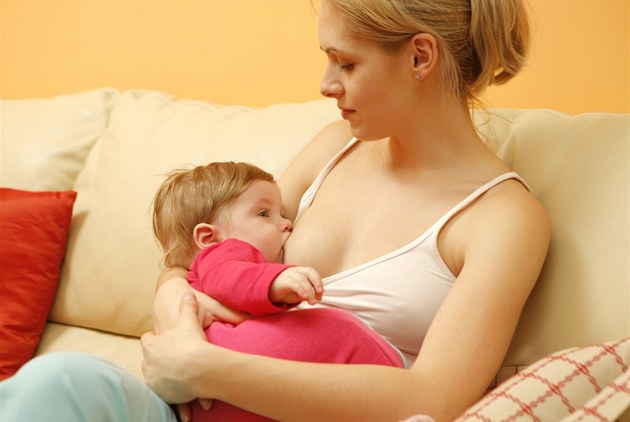 Examples are a poor suck or poor color.
Examples are a poor suck or poor color. - Fever in baby less than 12 weeks old. Caution: do NOT give your baby any fever medicine before being seen.
- Breathing stopped for more than 10 seconds and now it's normal
- Trouble breathing, but not severe
- Seizure suspected
- Your child looks or acts very sick
- You think your child needs to be seen, and the problem is urgent
Contact Doctor Within 24 Hours
- You think your child needs to be seen, but the problem is not urgent
Contact Doctor During Office Hours
- You have other questions or concerns
Self Care at Home
- Normal newborn reflexes and behavior
- Flying or mountain travel with a newborn
Seattle Children's Urgent Care Locations
If your child’s illness or injury is life-threatening, call 911.
- Bellevue
- Everett
- Federal Way
- Seattle
Care Advice for Newborn Reflexes and Behavior
- Normal Primitive Reflexes From Immature Nervous System:
- Startle Reflex (Moro or embrace reflex).
 Brief stiffening of the body, straightening of arms and opening of hands. Follows noise or abrupt movements. Frequent at birth. Slowly resolves by 4 months of age.
Brief stiffening of the body, straightening of arms and opening of hands. Follows noise or abrupt movements. Frequent at birth. Slowly resolves by 4 months of age. - Tonic-Neck Reflex (Fencer's Reflex). When head is turned to 1 side, the arm and leg on that side straightens. The opposite arm and leg flexes. Goes away by 4 months of age.
- Chin Trembling
- Lower Lip Quivering
- Jitters or Trembling (see Topic 2)
- Startle Reflex (Moro or embrace reflex).
- Normal Jitters or Trembling when Crying:
- Jitters or trembling of the arms and legs during crying is normal in newborns. It should stop by 1 to 2 months of age.
- If your baby is jittery when not crying, it could be abnormal. Give her something to suck on. (Reason: Normal trembling should stop with sucking.)
- Seizures are rare. During seizures, newborns are more than jittery. They have muscle jerking and blinking of the eyes. Babies can also make sucking movements of the mouth.
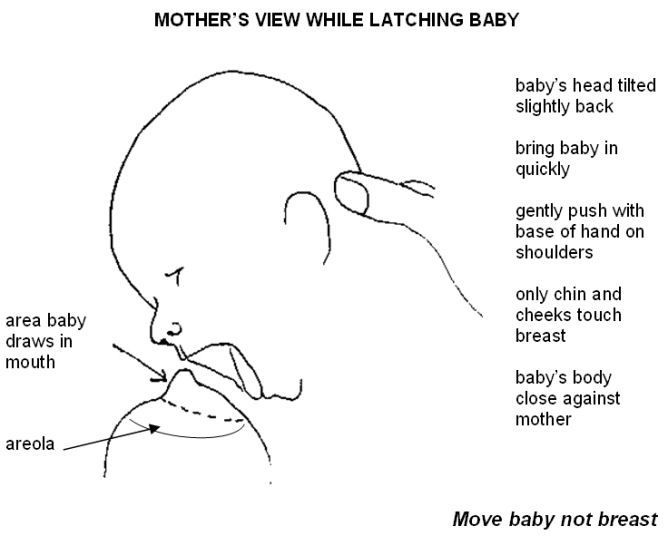 They don't cry during seizures.
They don't cry during seizures. - Call Your Doctor If:
- The jitters get worse
- The jitters occur when your baby is calm
- Normal Sleep Movements:
- Sleep is not quiet. Expect some of the following:
- Sudden jerks or twitches of the arms, hands or legs. If they only occur during sleep, they are most likely normal.
- How Long: last a few seconds, but can recur
- Timing: soon after falling asleep
- Normal at all ages, not just in newborns
- Suspect a seizure if: jerking occurs when awake or lasts more than 10 seconds
- Normal Breathing Sounds and Noises:
- Throat Noises. Caused by air passing through normal saliva or refluxed milk. These gurgling noises are likely to build up during sleep. Slowly, the newborn learns to swallow more often.
- Nasal Noises are usually caused by dried mucus in the nose. Your baby most likely doesn't have a cold.
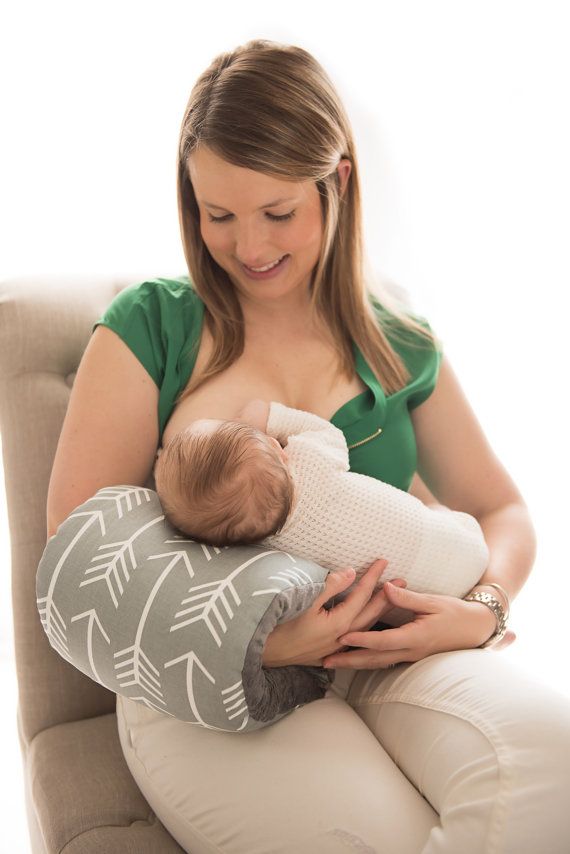 A blocked or stuffy nose can interfere with feeding. This is because your baby can't breathe when the mouth is closed with feeding. Therefore, babies need help opening the nasal passages.
A blocked or stuffy nose can interfere with feeding. This is because your baby can't breathe when the mouth is closed with feeding. Therefore, babies need help opening the nasal passages. - Nasal Saline. Clean out the nose with saline (salt water) nose drops (such as store brand). If not available, can use bottled water. Use 1 drop at a time and do 1 side at a time. Repeat this several times. This will loosen up the dried mucus. Then, it can be sneezed out or swallowed. If needed, use a suction bulb. Avoid Q-tips which can injure the lining of the nose. Saline nose drops or spray can be bought in any drugstore. No prescription is needed.
- Tobacco Smoke. Avoid tobacco smoke which can cause nasal congestion or sneezing. Avoid dust or any strong odors for the same reason.
- Call Your Doctor If:
- Nasal washes don't work
- Breathing becomes hard
- Normal Irregular Breathing Patterns:
- Transient Breathing Pauses of Less Than 10 Seconds.
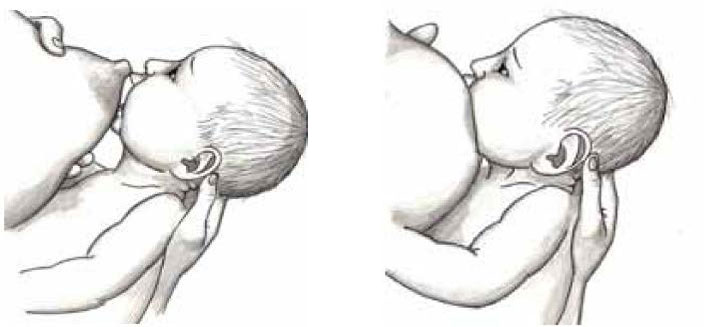 Also Called Periodic Breathing. Often, the pause is followed by some faster breathing to "catch-up." These breathing pauses are normal if the baby is comfortable during them. A normal rate should be less than 60 breaths per minute. Usually resolves by 1 month of age. Call your doctor if: Your baby is breathing fast or turned blue.
Also Called Periodic Breathing. Often, the pause is followed by some faster breathing to "catch-up." These breathing pauses are normal if the baby is comfortable during them. A normal rate should be less than 60 breaths per minute. Usually resolves by 1 month of age. Call your doctor if: Your baby is breathing fast or turned blue. - Transient Rapid Breathing. Sometimes, newborns take rapid, progressively deeper breaths. This is so they can expand their lungs all the way. This is normal if the breathing slows to normal within a minute or so.
- Seesaw Breathing. With breathing, the chest seems to contract when the stomach expands. The cause is the soft rib cage of some newborns. It tends to pull in during normal downward movement of the diaphragm.
- Yawning or Sighing (off and on) to open up the lungs
- Call Your Doctor If:
- Breathing becomes hard
- Breathing pauses last more than 10 seconds
- You have other questions or concerns
- Transient Breathing Pauses of Less Than 10 Seconds.
- Normal GI Sounds And Noises:
- Belching air from stomach
- Passing gas per rectum
- Note: Both of these are releasing swallowed air.
 They are normal, harmless and lifelong. They do not cause pain or crying.
They are normal, harmless and lifelong. They do not cause pain or crying. - Gurgling or growling noises from the movement of food through the intestines
- Normal grunting with pushing out stools
- Hiccups. Hiccups are often caused by overeating. They can also be from a little acid irritating the lower esophagus. Give your baby a few swallows of water to rinse off the lower esophagus.
- Normal Sleep Sounds And Noises: Normal sleep is not motionless or quiet. Expect some of the following:
- Moving during sleep transitions
- Occasional startle reflex or jerks
- Breathing noises - especially gurgling from secretions that sit in the throat.
- During light sleep, babies can normally whimper, cry, groan or make other strange noises.
- Parents who use a nursery monitor often become concerned about these normal sleep sounds.
- GI tract noises from normal movement of digested food
- Normal Feeding Reflexes:
- Rooting Reflex.
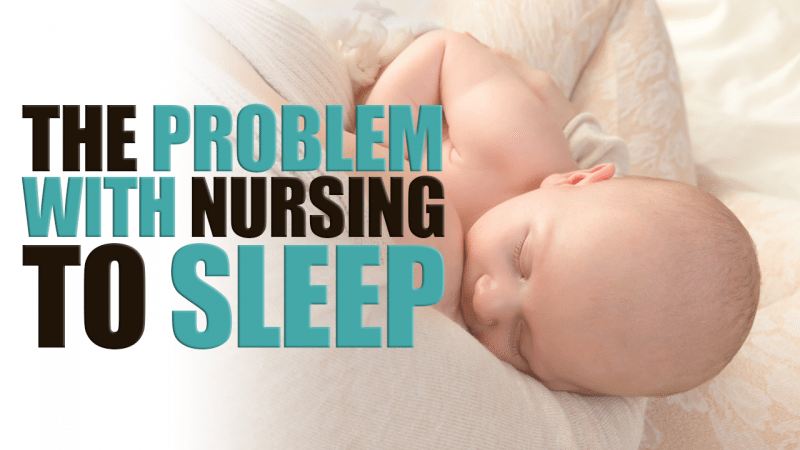 When the side of the mouth or cheek is touched, your baby turns to that side. He will open his mouth in preparation for nursing. Present until 6 months of age.
When the side of the mouth or cheek is touched, your baby turns to that side. He will open his mouth in preparation for nursing. Present until 6 months of age. - Sucking Reflex. Will suck on anything placed in the mouth. This survival reflex does not imply hunger. It is even present right after a feeding. This reflex fades between 6 and 12 months of age.
- Rooting Reflex.
- Normal Protective Reflexes:
- Sneezing To Clear Nose of Any Irritant. Sneezing helps to open the nose. It's usually caused by dust, fuzz, tobacco smoke or other strong odors. If sneezing becomes frequent, use nasal washes. This is not caused by an allergy.
- Coughing to clear lower airway
- Blinking. After spending 9 months in darkness, newborns have light-sensitive eyes. At first, they prefer to keep their eyes closed. They blink often with light exposure.
- Flying With Newborns:
- Never fly during the first 7 days of life.
 If flying is needed, it's safe to fly after 7 days of age.
If flying is needed, it's safe to fly after 7 days of age. - If your newborn is not healthy, do not fly. Your child's doctor should give medical clearance first before flying.
- Your baby can be exposed to infections aboard aircraft. Therefore, it is preferable not to fly before 2 or 3 months of age.
- Never fly during the first 7 days of life.
- Mountain Travel With Newborns:
- Avoid mountain travel above 8,000 feet (2,438 meters) for the first month of life. (Exception: family lives there year-round)
- Travel to destinations below 8,000 (2,438 meters) feet is safe.
- Brief drives over higher mountain passes are safe.
- If your newborn is not healthy, don't travel above 8,000 feet (2,438 meters). Your child's doctor should give medical clearance first.
- Call Your Doctor If:
- Your baby starts to look or act abnormal in any way
- You think your child needs to be seen
And remember, contact your doctor if your child develops any of the 'Call Your Doctor' symptoms.

Disclaimer: this health information is for educational purposes only. You, the reader, assume full responsibility for how you choose to use it.
Last Reviewed: 12/21/2022
Last Revised: 01/13/2022
Copyright 2000-2022. Schmitt Pediatric Guidelines LLC.
Child hyperactivity | Children's City Hospital
There is a playground where my 4-year-old daughter and I go to play, one boy, Alyosha. He's 5. To say that he is very active is an understatement.
Just for the almost 2 years that we have been going there, I have never seen him calmly play in the sandbox, swing on a swing or just sit next to his mother for at least 2 minutes. This is a hurricane, a whirlwind, a tornado - such comparisons can be made. He doesn't walk, he runs. And always. Spinning, spinning, stumbling, falling, pushing, throwing, with anything, in the end, he is exhausted, and departs home with his mother in hysterics ...
When we see Alyosha on the playground, we try to wait for him to leave. Other mothers said to each other that Alyosha had already been taken to a psychiatrist and diagnosed with hyperactivity...
Other mothers said to each other that Alyosha had already been taken to a psychiatrist and diagnosed with hyperactivity...
What is Attention Deficit Hyperactivity Disorder?
There are generally two different options. This, in fact, is a painful condition in which the help of a specialist is necessary, and features of the character, temperament and upbringing of the child.
The disease is called Attention Deficit Hyperactivity Disorder (ADHD) and has distinct features:
- unable to maintain attention during play and tasks;
- often "does not hear" what they say to him, and has no hearing problems;
- does not finish what he started;
- often loses things that are needed every day - toys, school supplies;
- finds it difficult to do anything on his own; easily distracted;
- forgetful in familiar everyday situations;
- constantly on the move, even while eating; nine0015 always does everything with noise; makes aimless movements;
- talks a lot; answers questions without hesitation;
- interferes with others, interferes with games and conversations;
- can't wait, stand in line.

If there are more than six of these signs and they are observed for six or more months in a row, it is highly likely that this is not a character and temperament, but a painful condition that requires the help of specialists.
In addition, children with ADHD simply cannot control themselves, cannot stop and calm down on their own, do not respond to prohibitions and remarks, are often impulsive and aggressive, do not finish anything, are quickly distracted and exhausted, speak quickly and a lot , ask millions of questions, but do not listen to the answers, are clumsy (dropping, breaking things), sleep poorly, they often have intestinal disorders and enuresis. nine0003
How to distinguish a simply active child from a hyperactive one
There is a simple way: if a child behaves the same EVERYWHERE - both at home, and at a party, and on the street, and in an unfamiliar environment, and in a children's team - this requires the help of specialists ( child neurologist, psychologist, psychiatrist). Consult, then either calm down and properly educate (more on this below), or confirm your doubts and be treated according to the recommendations of doctors.
Consult, then either calm down and properly educate (more on this below), or confirm your doubts and be treated according to the recommendations of doctors.
If a child is only noisy, restless and active at home, and sits “like a mouse” at a party, these are rather features of the character of such a child. This is exactly what happened to me with my child. The neurologist consulted, said that this is not a disease, but such a temperament; psychologist gave advice.
Why does this condition occur? Is it related to upbringing?
These are the questions that all parents worry about when a child is diagnosed. The number of children with ADHD, unfortunately, is growing every year. And now, according to various experts, they are from 3 to 10%. Boys among them are five times more than girls. nine0003
The causes of this condition are not fully known, but:
- environmental degradation;
- infectious diseases of the mother during pregnancy;
- abnormal delivery;
- birth injuries
. .. ... play an important role in the development of this condition.
.. ... play an important role in the development of this condition.
It is not connected with insufficiently tough upbringing (as some parents think, the child is not just “indulging” and “not obeying”), tougher penalties only worsen the situation with behavior. nine0003
"If you scold me and say I'm bad, then you'll know how bad I can be!" - this is the result.
What is the main problem of children with ADHD and what to do about it?
The main problem is that such children cannot adapt to society. Due to their impulsiveness, uncontrolled aggression, such children ignore the generally accepted rules of behavior, harming themselves and others. Which inevitably leads to problems. With development, study, communication.
And one more thing. According to statistics, 80% of people who are in prison were hyperactive children. Think about it and do not delay treatment. It won't go away on its own!
How can parents help such a child?
Dealing with Hyperactivity in a Child I have a very active child myself.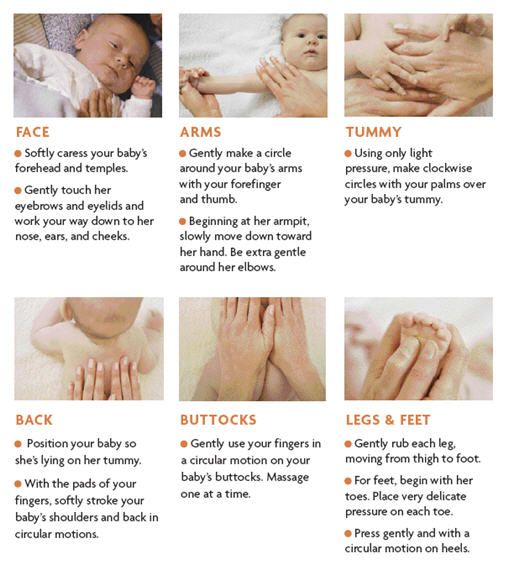 This, thank God, is just such a temperament, but it is also suitable for children diagnosed with ADHD. And the psychologist taught us how to properly handle it, in order to live a little more ourselves.
This, thank God, is just such a temperament, but it is also suitable for children diagnosed with ADHD. And the psychologist taught us how to properly handle it, in order to live a little more ourselves.
- Try to establish contact with the child before demanding anything from the child. Touch, hold hands.
- Look into his eyes and then talk to him. Why do it? Because when a child is busy with something, passionate, playing - he is all there, in his experiences, and does not hear you. It really helps - I take my daughter by the hand, look into her eyes, tell her what I need her to do, and in most cases it helps.
- Set permanent rules. Stick to it strictly. The rules for the child should be clear and simple. For example, if today you can’t eat sweets before meals, touch someone else’s dog, jump from a swing, be rude to your grandmother, open a gas valve, then tomorrow it’s impossible. nine0016
- It is important to follow the sequence of actions, break complex tasks into several simple ones - this will make it easier for the child to cope.
 How do I apply it? I say: “Let's clean the children's room. First we make the bed. To do this, we straighten the sheets, pillows, cover with a bedspread. Then we collect toys. Cars - in a box, dolls - on a doll table, cubes - in a box. And so on, until we remove everything.
How do I apply it? I say: “Let's clean the children's room. First we make the bed. To do this, we straighten the sheets, pillows, cover with a bedspread. Then we collect toys. Cars - in a box, dolls - on a doll table, cubes - in a box. And so on, until we remove everything. - Always observe the regime in everything. Literally by the hour, get up, eat, walk, go to bed. Always, any day of the week. It really helps. And adults too. nine0016
- Praise. But wisely. Something done well - praise. Listened - praise. Find something that your child is best at and praise for it. My daughter, for example, loves to help prepare her dad's breakfast. And literally melts with pleasure when I praise her for it. And the mood is good for half a day.
- Try to spend excess energy. Excess energy goes away - the child becomes calmer. Checked on myself. It is important not just to run, but to “put energy in the right direction” - dancing, acrobatics, athletics, swimming pool ...
- If you are going somewhere (travel, guests, shop), prepare in advance.
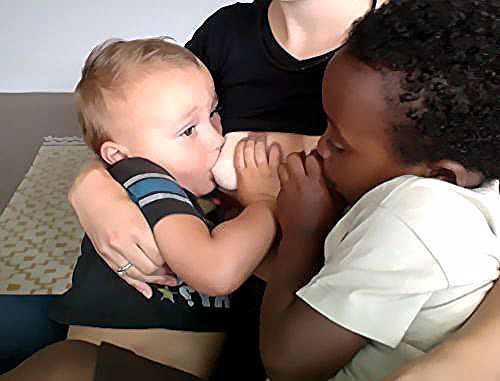 Discuss with your child where you are going, what you will do there and how you should behave.
Discuss with your child where you are going, what you will do there and how you should behave. - Use every opportunity to relax - entrust grandparents, aunts and uncles to play, walk with the child, in general, those to whom you can entrust the child, without forgetting to give them detailed instructions. Otherwise, all efforts will go down the drain.
Your child needs adequate parents, right? Then think a little about yourself. nine0003
Health and patience to you and your children!
Various breastfeeding positions
Try different breastfeeding positions to find the one that works best for you and your baby. You can see the options in our selection of photos
Share this information
There is no right or wrong way to hold the baby while
feeding, and mom and baby are sure to find their favorite position. nine0119 It is important that both you and your child feel comfortable. 1.2 It's good to learn a few different breastfeeding positions and techniques because life's circumstances often require us to be flexible, especially as your baby gets older and you start to leave the house more often.
1.2 It's good to learn a few different breastfeeding positions and techniques because life's circumstances often require us to be flexible, especially as your baby gets older and you start to leave the house more often.
Whatever position you choose to breastfeed your baby, remember a few simple rules.
- Prepare everything you need before feeding, including drinks, food, mobile phone, TV remote control, book or magazine. And do not forget to go to the toilet - the feeding process can take a long time! nine0016
- Make sure your baby is comfortable. Whichever position you choose, it's important to keep your baby strong, level, and provide good support for their head, neck, and spine.
- You should also be comfortable. Don't stress. If necessary, use pillows of different sizes or rolls of towels to support your back or arms.
- Make sure your baby is latching on correctly. Proper grip is the key to comfort when breastfeeding. nine0016
- If your baby does not latch on well or you experience pain while feeding, contact a lactation consultant for help.
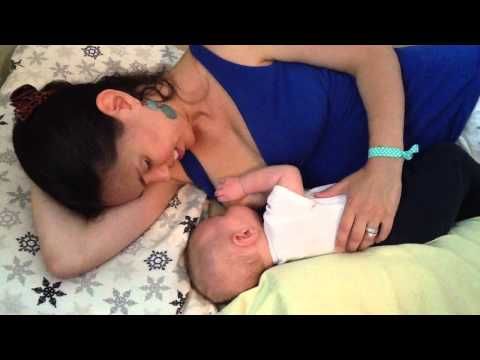 The specialist will also be able to show you how to hold your baby more comfortably.
The specialist will also be able to show you how to hold your baby more comfortably.
1. Relaxed feeding or reclining position
The relaxed feeding position, also known as biological feeding, 1 is often the first position for most mothers. If, immediately after birth, the baby is placed on the mother’s chest or stomach, normally, he instinctively reaches for the breast and tries to grab the nipple. This phenomenon is known as the breast seeking reflex. Skin-to-skin contact stimulates the infant's feeding instinct, and gravity helps him to latch onto the breast and maintain balance. nine0003
But it's not just newborns that can be fed in the reclining position - this position is great for babies of all ages. It can be especially helpful if your baby does not latch well in other positions or does not like to be touched during feeding, and also if you have too much milk flow or too large breasts. Isabelle, a mother from the UK, shares her experience: “I had large breasts, and the baby was born small - 2. 7 kg, so it was not easy to find a comfortable position at first. After a few weeks, it became clear that there was no “correct” posture for me. As a result, I most often fed lying down, putting the baby on my chest. ” nine0003
7 kg, so it was not easy to find a comfortable position at first. After a few weeks, it became clear that there was no “correct” posture for me. As a result, I most often fed lying down, putting the baby on my chest. ” nine0003
It is more convenient to feed not lying flat on your back, but half-sitting, leaning on pillows. So you will have a back support and you will be able to watch the baby during feeding.
2. Cradle position
This is the classic
position that comes to mind when breastfeeding a baby. Mom sits
straight, and the baby lies on her side on her arm, pressing her stomach against her stomach. 3 Although this is a very popular position, it is not always easy to master with newborns because it gives the baby less support. Try putting a pillow under your back, and put a special breastfeeding pillow on your knees and lean on it with your hands. So you can more reliably support the child, without overstraining your back and shoulders. Just make sure that the baby does not lie too high on the pillow for feeding. The breast should remain at a natural level so that the baby can grab it without effort, otherwise sore nipples cannot be avoided. nine0003
Just make sure that the baby does not lie too high on the pillow for feeding. The breast should remain at a natural level so that the baby can grab it without effort, otherwise sore nipples cannot be avoided. nine0003
“I breastfed in the cradle position because it suited me perfectly! It was comfortable and I loved just sitting and looking at my little one,” recalls Rachel, a mother of two from Italy.
3. Cross Cradle
This breastfeeding position looks almost the same as Cradle, but the baby is on the other arm. 3 This gives baby support around the neck and shoulders so he can tilt his head to latch on. This position is great for breastfeeding newborns and small babies, as well as for babies who do not latch well. Since the baby lies completely on the other hand, it becomes easier to control his position and you can adjust the chest with your free hand. nine0003
Julie, a UK mother of two, finds this position very practical: “I usually breastfeed my youngest in the cross cradle position. So I have a free second hand, and I can take care of an older baby at the same time. ”
So I have a free second hand, and I can take care of an older baby at the same time. ”
Do not hold the baby's head at first, otherwise you may inadvertently press his chin against his chest. Because of this, the child will not be able to take the breast deeply, because the nipple will rest against the base of the tongue, and not against the palate, which will lead to inflammation of the nipples. As the child grows, this position becomes more comfortable, and he can rest his head on your palm (as shown in the photo above). nine0003
4. Underarm breastfeeding
In this position, also known as the “ball grip”, the mother sits with the baby lying along her arm at the side, legs towards the back of a chair (or any other seat). 3 This is another comfortable position for newborn breastfeeding, in which you can give your baby good support, have full control of his position, and have a good view of his face. And the baby feels safe in close contact with the mother's body. This position is especially good for those who have had a caesarean section or a premature birth, as well as mothers of twins and women with large breasts. nine0003
This position is especially good for those who have had a caesarean section or a premature birth, as well as mothers of twins and women with large breasts. nine0003
“When I breastfed my first daughter, I had very large K-sized breasts—twice the size of her head,” recalls Amy, an Australian mother of two. - I put rolls of towels under each breast, because they were very heavy, and fed my daughter in a pose from under the arm, but only sitting straighter so as not to crush her. This position was also convenient because I had a caesarean section and could not put the baby on my stomach.”
5. Side-lying position
The side-lying position is ideal for relaxed
night feedings in bed or on the couch. If you had a
caesarean section or ruptures during childbirth, this position may be more comfortable than sitting down. 3 In this position, mother and baby lie side by side, tummy to tummy.
“It was difficult for me to sit during endless night feedings, firstly because of the caesarean section, and secondly because of lack of sleep,” recalls Francesca, a mother from the UK.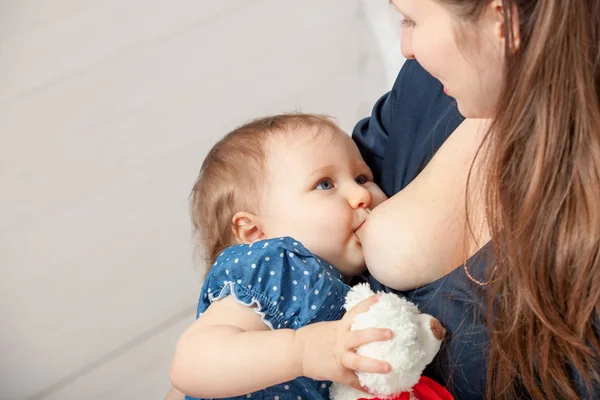 “And then I discovered that you can feed your baby lying on your side and rest at the same time.” nine0003
“And then I discovered that you can feed your baby lying on your side and rest at the same time.” nine0003
“Because of the short tongue frenulum, Maisie could only properly latch on to her breasts while lying on her side. The lactation consultant showed me how it's done. In this position, the flow of milk was optimal for my daughter, and it was easier for her to keep the nipple in her mouth. As she got older, she became much better at grabbing her breasts in normal positions,” says Sarah, mother of two from Australia.
6. Relaxed breastfeeding after caesarean section
If you can't find a comfortable position for breastfeeding after caesarean section, 3 try to hold the baby on the shoulder while reclining — this does not put pressure on the postoperative suture and allows you to breastfeed the baby comfortably. You can also try side feeding.
7. Sitting upright breastfeeding or “koala pose”
When breastfeeding in an upright position or “koala pose”, the baby sits with a straight back and a raised head on the mother's hip. 4 This position can be tried even with a newborn if it is well supported, but it is especially convenient for feeding an older child who can already sit up by himself. The upright sitting position, or “koala pose,” is great for toddlers who suffer from reflux or ear infections and feel better sitting. In addition, this pose may be suitable for children with a shortened frenulum of the tongue or reduced muscle tone. nine0003
4 This position can be tried even with a newborn if it is well supported, but it is especially convenient for feeding an older child who can already sit up by himself. The upright sitting position, or “koala pose,” is great for toddlers who suffer from reflux or ear infections and feel better sitting. In addition, this pose may be suitable for children with a shortened frenulum of the tongue or reduced muscle tone. nine0003
“When my daughter got a little older, I would often feed her in an upright position, which was more comfortable for both of us, and I could still hold her close,” recalls Peggy, a mother from Switzerland. “Besides, it was possible to discreetly breastfeed her in public places.”
8. Overhanging position
In this position, the baby lies on his back, and the mother bends over him
on all fours so that the nipple falls directly into his mouth. 4 Some moms say this breastfeeding position is good to use from time to time for mastitis, when touching the breasts is especially unpleasant. Some say that this breastfeeding position helps with blockage of the milk ducts, although there is no scientific evidence for this yet. You can also feed in the “overhanging” position while sitting, kneeling over the baby on a bed or sofa, as well as reclining on your stomach with support on your elbows. Pillows of various sizes that you can lean on will help you avoid back and shoulder strain. nine0003
Some say that this breastfeeding position helps with blockage of the milk ducts, although there is no scientific evidence for this yet. You can also feed in the “overhanging” position while sitting, kneeling over the baby on a bed or sofa, as well as reclining on your stomach with support on your elbows. Pillows of various sizes that you can lean on will help you avoid back and shoulder strain. nine0003
“I have breastfed several times in the 'overhang' position for clogged milk ducts when no other means of dissolving the blockage worked. And this pose seems to have helped. I think it's because of gravity, and also because the breasts were at a completely different angle than with normal feeding, and my daughter sucked her differently, ”says Ellie, a mother of two from the UK.
Feeding in the "overhanging" position is unlikely to be practiced regularly, but in some cases this position may be useful. nine0003
“I used to breastfeed in the overhang position when my baby was having trouble latch-on,” says Lorna, mother of two in the UK. - This, of course, is not the most convenient way, but then I was ready for anything, if only he could capture the chest. We succeeded and have been breastfeeding for eight months now!”
- This, of course, is not the most convenient way, but then I was ready for anything, if only he could capture the chest. We succeeded and have been breastfeeding for eight months now!”
9. Feeding a baby in a sling or "on the fly"
Breastfeeding in a sling takes some practice, but it can be used to go out of the house, look after older children or even do a little household chores. nine0003
The sling is also useful if the baby does not like to lie down or is often attached to the breast. Lindsey, a mother of two in the US, notes: “I used the carrier frequently for both of my children. When we were out, I tied the sarong around my neck and covered the carrier with it. Under such a cape, the baby can eat as much as he wants until he falls asleep.
This breastfeeding position is best when the baby is already good at breastfeeding and can hold his head up by himself. Any slings are suitable for breastfeeding, including elastic and rings, as well as carrying bags. Whatever option you choose, the main thing is that you can always see the face of the child, and his chin does not rest against his chest. nine0003
Whatever option you choose, the main thing is that you can always see the face of the child, and his chin does not rest against his chest. nine0003
10. Double hand-held breastfeeding
Double hand-held breastfeeding (or “double-ball grab”) is great for mothers of twins—you can breastfeed both at the same time and keep your arms relatively free. 4 When feeding in this position, it is advisable to use a special pillow for breastfeeding twins, especially at first. It will provide extra support and help keep both babies in the correct position, as well as reduce the burden on the abdomen if you had a caesarean section. In addition, the hands are freer, and if necessary, you can deal with one child without interfering with the second. nine0003
“My twins were born very tiny and had to be fed every two hours at any time of the day or night. Very soon it became clear: if I want to do anything besides feeding, I need to feed them both at the same time, - says Emma, mother of two children from the UK. “I breastfed them two by hand using a breastfeeding pillow.”
“I breastfed them two by hand using a breastfeeding pillow.”
Other good positions for breastfeeding twins are two criss-cross cradles, one baby in the cradle and the other close at hand, reclining feeding, or sitting upright (one baby on one side, the other on the other). nine0003
11. Breastfeeding in the “arm-supported” or “dancer's-arm” position
muscle tone (which is typical for premature babies, children suffering from various diseases or Down syndrome), try supporting his head and your chest at the same time. 4 Grasp your chest with your palm underneath so that your thumb is on one side and all the others are on the other. Move your hand slightly forward so that your thumb and forefinger form a "U" just in front of your chest. With the other three fingers, continue to support the chest. With your thumb and forefinger, hold the baby's head while feeding so that his chin rests on the part of the palm between them, your thumb gently holds the baby on one cheek, and your index finger on the other. So the baby gets excellent support, and you can control his position and see if he is holding his breast. nine0003
So the baby gets excellent support, and you can control his position and see if he is holding his breast. nine0003
Literature
1 Colson SD et al. Optimal positions for the release of primitive neonatal reflexes stimulating breastfeeding. Early Hum Dev . 2008;84(7):441-449. - Colson S.D. et al., "Optimal Positions for Provoking Primitive Innate Reflexes to Induce Breastfeeding." Early Hume Dev. 2008;84(7):441-449.
2 UNICEF UK BFHI [ Internet ]. Off to the best start ; 2015 [ cited 2018 Feb ]. - UNICEF UK, Baby-Friendly Hospital Initiative, Start the Best You Can [Internet]. 2015 [cited February 2018].
3 Cadwell K. Latching - On and Suckling of the Healthy Term Neonate: Breastfeeding Assessment.


